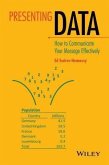Preface ix
1. Attention and Aesthetics 1
1.1. Attention, 1
1.1.1. What Is It That Attracts Our Attention? 2
1.1.2. Negative Information Attracts More Attention, 2
1.1.3. The Myths of Prehistoric Civilization, 5
1.2. Gestalt Principles, 6
1.2.1. Closure and Completeness, 6
1.2.2. Continuity and Smoothness, 8
1.2.3. Missing the Obvious, 9
1.3. Aesthetics, 11
1.3.1. The Golden Ratio, 11
1.3.2. Simplicity, 12
1.3.3. Regularity, 14
1.3.4. Beauty, 15
1.4. The Index of the Interesting, 17
1.4.1. Belief Updates, 18
1.4.2. Proteus Phenomenon, 18
1.4.3. Surprises, 19
1.4.4. Connecting the Dots, 23
1.5. Summary, 24
Bibliography, 25
2. Mental Models 27
2.1. Mental Models, 27
2.1.1. Pitfalls, 29
2.1.2. Communicating with Aliens, 31
2.1.3. Boundary Objects, 32
2.1.4. Wrong Models, 33
2.1.5. Competing Hypotheses, 41
2.2. Creativity, 47
2.2.1. Divergent Thinking, 49
2.2.2. Blind Variation and Selective Retention, 51
2.2.3. Binding Free-Floating Elements of Knowledge, 52
2.2.4. Janusian Thinking, 54
2.2.5. TRIZ, 57
2.2.6. Reasoning by Analogy, 59
2.2.7. Structural Holes, Brokerage, and Boundary Spanning, 59
2.3. Foresights, 61
2.3.1. Information Foraging, 61
2.3.2. Identifying Priorities, 63
2.3.3. Hindsight on Foresight, 65
2.4. Summary, 66
Bibliography, 67
3. Subjectivity of Evidence 71
3.1. The Value of Information, 71
3.2. Causes Célèbre, 74
3.2.1. The Sacco and Vanzetti Case, 74
3.2.2. The O.J. Simpson Case, 79
3.2.3. Ward Edwards's Defense of Bayesian Thinking, 86
3.3. The Da Vinci Code, 87
3.3.1. Positive and Negative Reviews, 88
3.3.2. Decision Trees, 90
3.4. Supreme Court Opinions, 93
3.5. Apple versus Samsung, 100
3.6. Summary, 101
Bibliography, 101
4. Visualizing the Growth of Knowledge 103
4.1. Progressive Knowledge Domain Visualization, 105
4.1.1. The Structure of a Knowledge Domain, 106
4.1.2. Research Fronts and Intellectual Bases, 108
4.1.3. Strategies of Scientific Discoveries, 111
4.2. CiteSpace, 116
4.2.1. Design Rationale, 117
4.2.2. Basic Procedure, 119
4.2.3. Advanced Cocitation Analysis, 122
4.2.4. Toward a Tightly Connected Community, 128
4.3. Examples, 132
4.3.1. Terrorism Research, 132
4.3.2. Mass Extinctions, 136
4.3.3. Developing Expertise in Analytics and Topic Areas, 140
4.3.4. U.S. Supreme Court Landmark Cases, 142
4.4. Summary, 143
Bibliography, 143
5. Fitness Landscapes 147
5.1. Cognitive Maps, 147
5.1.1. The Legibility of Cognitive Maps, 147
5.1.2. Spatial Knowledge, 148
5.2. Fitness Landscapes, 149
5.2.1. Wright's Adaptive Landscapes, 150
5.2.2. Fisher's Geometric Model of Adaptation, 153
5.2.3. The Holey Landscape, 155
5.2.4. Kauffman's NK Model, 156
5.2.5. Local Search and Adaptation, 157
5.2.6. Criticisms, 158
5.3. Applications of Fitness Landscapes, 159
5.3.1. Structure-Activity Relationship Landscapes, 159
5.3.2. Landscapes Beyond Evolutionary Biology, 161
5.4. Summary, 169
Bibliography, 170
6. Structural Variation 173
6.1. Complex Adaptive Systems, 173
6.1.1. Early Signs of Critical Transitions, 173
6.1.2. Early Signs of Great Ideas, 175
6.1.3. The Structural Variation Theory, 176
6.2. Radical Patents, 181
6.2.1. Patentability, 181
6.2.2. NK Models of Recombinant Patents, 182
6.2.3. Recombinant Search for High-Impact Radical Ideas, 184
6.2.4. Radical Inventions, 188
6.2.5. Genetically Evolved Patentable Ideas, 189
6.3. Bridging the Gaps, 192
6.3.1. The Principle of Boundary Spanning, 192
6.3.2. Baseline Networks, 193
6.3.3. Structural Variation Metrics, 195
6.3.4. Statistical Models, 198
6.4. Applications, 199
6.4.1. Small-World Networks, 200
6.4.2. Complex Network Analysis (1996-2004), 201
6.4.3. National Cancer Institute's Patent Portfolio, 203
6.4.4. A Follow-Up Study, 211
6.5. Summary, 212
Bibliography, 212
7. Gap Analytics 217
7.1. Portfolio Analysis and Risk Assessment, 218
7.1.1. Portfolios of Grant Proposals, 219
7.2. Interactive Overlays, 225
7.2.1. Single-Map Overlays, 225
7.2.2. Dual-Map Overlays, 226
7.3. Examples of Dual-Map Overlays, 231
7.3.1. Portfolios of a Single Source, 231
7.3.2. Portfolios of Organizations, 234
7.3.3. Portfolios of Subject Matters, 239
7.3.4. Patterns in Trajectories, 243
7.4. Summary, 246
7.5. Conclusion, 247
Bibliography, 250
Index 253









